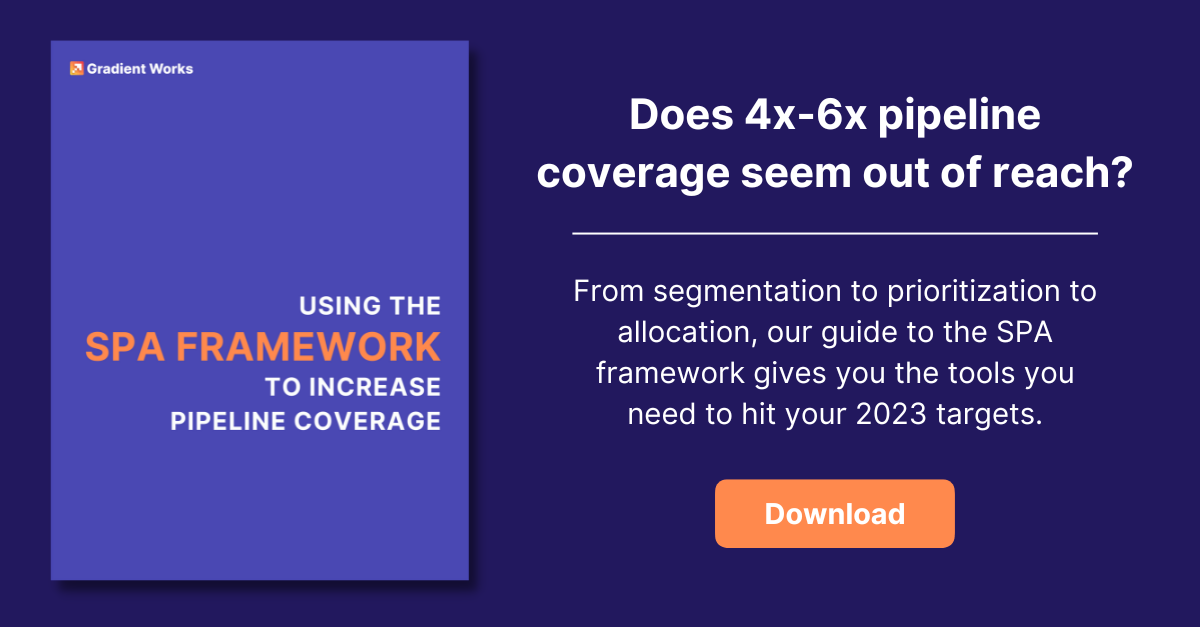Today, we're going to talk about how to find the right account scoring model and methodology for your B2B revenue organization.
If you've never scored accounts before, there's a ton of info below to help you get started. But even if you already have a score and just want to refine it, this should help you take the next steps.
All of this assumes you're using an account-based sales motion, so we're talking about how to score accounts. But these concepts can apply to lead scoring as well.
You can score accounts on a numerical scale (like 1-10) or group them into tiers (like A, B, C or high, medium, and low priority). Or you may first score them with a specific number, then group those scores together into tiers. For example, anyone with a score of 8-10 goes into Tier 1, accounts with 5-7 go into Tier 2, and those with a score of 4 or below are Tier 3. Pick whatever scoring system makes sense for your company.
But the real question is - what methodology do you use to develop your account scores? Let's talk about some of the possible B2B account scoring with examples.
The types of account scoring models
The most common B2B account scoring models are:
1. Rule-based models
These models use a set of rules to score accounts. The rules are based on factors such as company size, industry, and location, and have been manually created by humans.
Rule-based models are the simplest to create and what most companies start with, but are likely not as accurate as statistical or machine-learning models. The rules for these models could be based on a number of factors, including
-
Firmographic rules: These rules are based on an account’s firmographic or technographic characteristics, such as company size, industry, location, or technology use. These are ICP fit rules.
-
Behavioral rules: These rules are based on an account’s behavior, such as website visits, marketing activities, social media engagement, and email engagement. These rules tend to attempt to identify high-intent behaviors to surface accounts that are currently in-market for a solution. These are ICP timing rules.
Firmographic rules are a good starting point for scoring accounts because they’re relatively simple to set up and automate with basic data enrichment. However, those rules can be less accurate than other kinds of rules, as they don’t take into consideration the individual behavior of each account. Behavioral or intent rules can be more accurate, especially when paired with firmographic rules, but intent data can be harder (and more expensive) to come by. Behavior rules may also require some kind of real-time automation beyond simple data enrichment. You can read more about intent and the customer lifecycle here.
We recommend starting simply with a few firmographic rules, paired with some behavior rules to fully capture fit and timing for accounts. This will give you the highest success rate at identifying the highest-potential accounts.
2. Statistical models
These models use statistical algorithms to score accounts. The algorithms are trained on data from past sales and marketing campaigns. These are more complex to set up and will require some specialized statistical experience and knowledge on your team.
3. Machine learning, ML, scoring models
These models use machine learning algorithms to score accounts. The algorithms are trained on data from past sales pipeline data, marketing campaigns, as well as data from other sources, such as social media and customer reviews, to create an account score based on previous accounts’ lifecycles. This will likely require a separate machine-learning product or an ML developer to implement. Because of this, it's a more advanced model and better suited for more mature companies.
4. Hybrid models
These models combine two or more of the above models. For example, a hybrid model might use a rule-based firmographic model to score accounts initially, and then use a machine learning model to refine the scores over time.
Choosing the right scoring model
Here are some of the factors to consider when choosing a model:
-
Data availability: Select a model that can use the data you currently have available to your business.
-
Accuracy: The model should be as accurate as possible in predicting which accounts are most likely to buy. Take the time for historical data analysis to fully understand what criteria are highly correlated to a successful customer.
-
Complexity: The model should be easy to understand and implement. The more complex the model is, the harder it will be to set up and maintain.
-
Cost: The model should be affordable. If you can’t afford an expensive intent data provider, start with a simpler scoring model that uses data you already have.
If you're just getting started with account scoring, then we recommend a super simple rules-based model to start. Put it in place for a few months, then go in to review and see what you should tweak. Have the highly-scored accounts turned into qualified opportunities? Review it at least once a quarter, and make adjustments as necessary. You'll likely find some things you should include that you didn't at first, as well as some things you can remove from your score entirely.
As your company or sales team matures, then you can integrate more complicated models like a statistical or machine learning model. Ideally, you'd do these in conjunction with your rules-based model to create something accurate (and always improving in accuracy), but also relatively easy to understand why an account scores the way it does.
A rules-based account scoring model example
At Gradient Works, we've evolved our account scoring method over time. We're still relatively early stage, so our model is a simple rules-based model for now. As we grow, we'll incorporate machine learning into the model, but we're not there yet. Still plenty of room to improve our rules manually first.
We started with a set of firmographic rules to create our initial account score. You can even use a simple spreadsheet to calculate these scores, then input them into a field on the account object in your CRM (if you're account based, that is - you may prefer to put it on the lead or contact object, depending on how you assign prospect accounts to sales reps).
We sell to high-velocity B2B sales teams, so a few of our initial account scoring criteria were:
- Is a B2B company
- Has 25 or more sales reps
- Sells a subscription product
- Has a self-service or free trial option
- Has an ASP of $1,000 - $100,000
A company got 1 point in this point system for each of these criteria they matched, and the higher the score, the higher potential we considered that account. These simple criteria helped us identify accounts that would have a complex and large enough sales cycle to need our dynamic books software. They're also very simple to identify by quickly looking at a company's website, Zoominfo profile and/or LinkedIn profile.
As we matured the model, we refined the firmographic and technographic criteria we look for. A company has to use Salesforce as its CRM to use Gradient Works right now, so that doesn't go into our scoring criteria (it's a binary qualified/unqualified signal), but we do look for companies that use other sales tech, like an intent provider such as 6sense. A company doesn't have to use 6sense to use Gradient Works, but many of our customers do, so it's a positive indicator of success. Accounts get a point for that.
We also added behavior/intent rules to our scoring model. For example, accounts that have visited our website multiple times over multiple sessions, have multiple contacts engaging with our marketing materials, or visit high-intent pages on our website (such as demo request and product tour pages) get points for those behaviors.
We then assign new high-score accounts to sales reps automatically using our very own product (Gradient Works), so that our sales team always has the most current and highest-potential accounts in their books at all times. It helps us call on accounts that are both high fit and actively signaling their intent.
That's how we started, and it's a great place for anyone to start. Start simple and small, and iterate your way to something more complex as you learn how accurate your scoring is.





